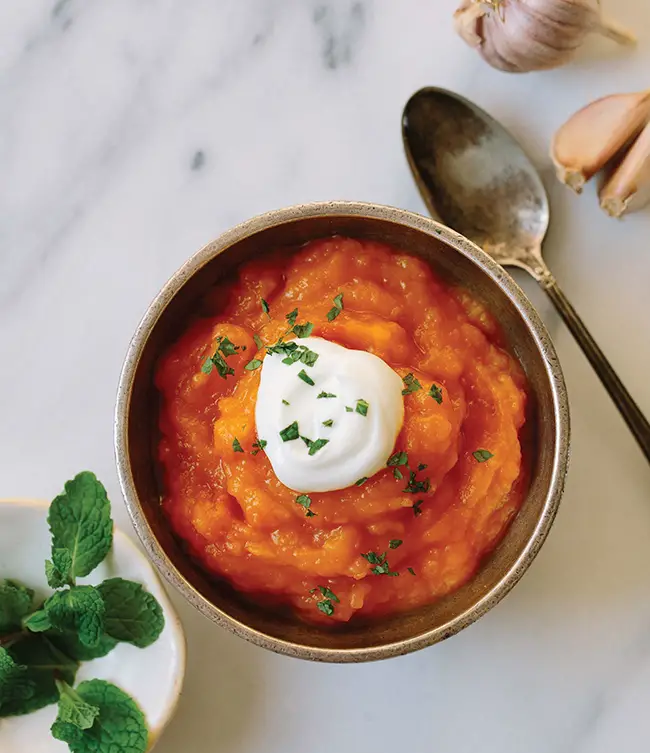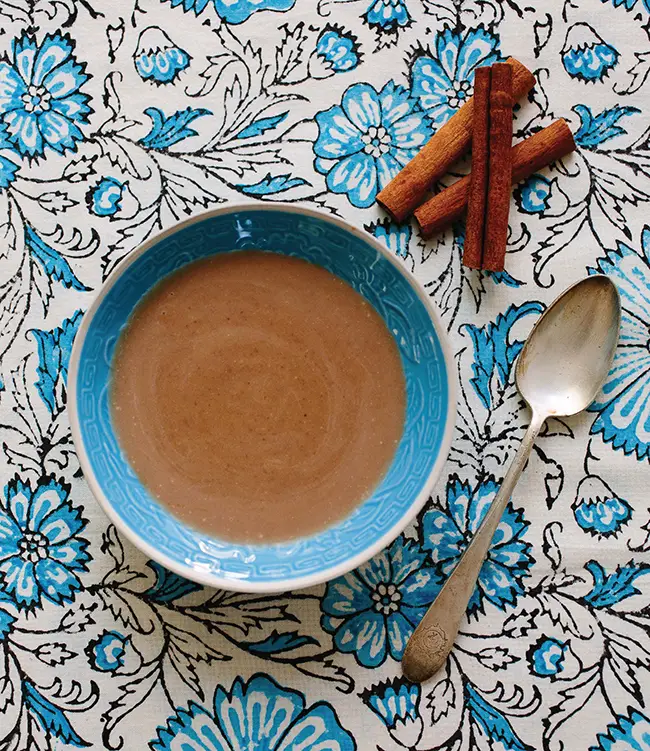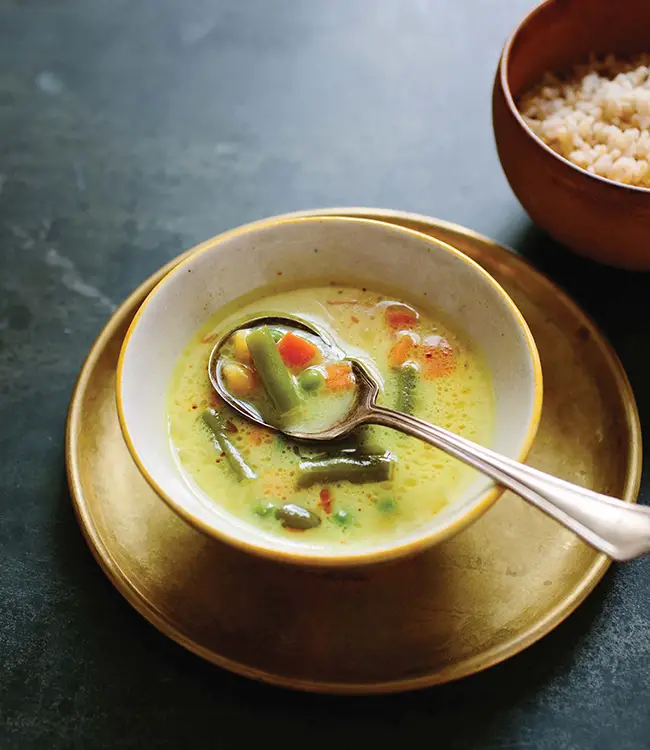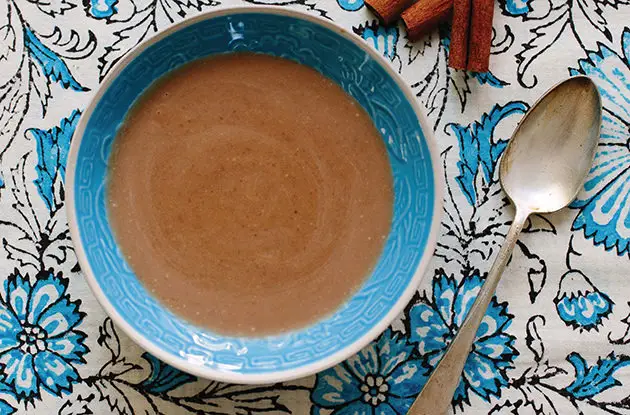Remember that not all spices are spicy. In fact, a spice is just an aromatic ingredient used to season food—it can be hot and spicy, but it doesn’t have to be.
“Baby-friendly” spices are those whose flavor is relatively mild, easy on new taste buds, and simple to digest. They are not short on flavor, just heat—think of spices such as cinnamon, saffron, cardamom, and clove. Baby-friendly savory spices, such as basil, coriander, cumin, and turmeric, pair well with vegetables and add depth to your little one’s first bites.
Introducing seasoning is easy. When your baby becomes comfortable with a certain food— say, mashed banana or applesauce—kick it up a notch by adding a pinch of something from your spice cabinet. Start with ground cinnamon (one of the most baby-friendly spices, in my opinion) or a saffron thread. Over time, you can add multiple seasonings and different ingredients to broaden your baby’s palate, working up to full-seasoned meals—even adding a tiny drop of hot sauce or vinegar, as fits the occasion. Try freshly squeezed lemon or lime juice in vegetable purees (also vary the vegetable—instead of carrots, try parsnips with dill; instead of spinach, try kale with garlic) or add a dash of fish sauce to soups and meats (think salmon with lemon, or chicken with coconut milk). Remember the flavors you enjoy and incorporate them into your baby’s meals.
Just go slowly, adding one new flavor at a time, and don’t give up if the first taste isn’t a success. Parents commonly assume that if their baby spits out some food, she doesn’t like it. That may not be the case. Your baby’s taste buds are developing at their own pace, and they need practice to recognize and appreciate new flavors. Don’t give up!
Safe for Baby
You’re probably thinking, can I really put that in my baby’s food? It’s natural—and important—to want to make sure that every ingredient you feed your baby is safe and able to be easily digested. Adding herbs and spices to your baby’s first bites is not only safe but also possibly beneficial. Turmeric has known antiseptic properties, and fennel is known to soothe an upset tummy. Even gripe water, a famous colic remedy, is made with dill, ginger, fennel, and chamomile. Let’s not forget that parents around the world have been feeding their babies spices for centuries.
To safely introduce spices and herbs, follow these simple steps:
- Listen to your baby’s doctor. Most pediatricians recommend introducing herbs and spices after six months of age.
- Treat each seasoning like a new food. After your baby’s first taste of a new ingredient, wait to see if he is sensitive or allergic to it before cooking with it again.
- Add just a pinch to start. A little goes a long way for tiny taste buds! Over time you can increase the amount, working up to fully seasoned meals.
- Use baby-friendly spices.
- Always buy good-quality herbs and seasonings. Make sure spice blends aren’t adulterated with preservatives or fillers.
- Clean all ingredients appropriately before using them. Even if you peel something or discard the rind, wash it first. Bacteria can hide on the outside of fruits and vegetables and attach to your knife as you cut.
- Taste the seasoned meal you plan to serve to make sure the flavor is not too strong. If you think the dish tastes good, chances are your baby will, too!
|
Kadu Borani
From Afghanistan • Makes approximately 4 cups
Yogurt is a traditional Afghani condiment and ingredient, often made fresh at home every few days. It’s used in kadu borani (pronounced “ka-doo bore-ah-nee”), a side dish made by frying pumpkin (kadu) with a sweet tomato sauce that is served topped with garlic-mint yogurt (borani). You can substitute any squash for the pumpkin, or use canned puree.

Ingredients
- 2 small sugar pumpkins (about 2 pounds)
- 1 teaspoon olive oil
- 1 Roma tomato, chopped
- 3 fresh mint leaves, chopped, or pinch dried mint
- 1-2 thin slices peeled fresh garlic
- Pinch ground coriander
- 2 tablespoons plain whole-milk yogurt, for babies older than 8 months
|
Prep: Preheat oven to 350° F. Remove pumpkin stems. Cut pumpkins in half and use a spoon to scoop out seeds. Cut each pieces in half again and place on a baking sheet. Bake for 45 to 50 minutes, until soft and fork-tender. Let cool and peel skin, which should come off easily. Puree pumpkin and a few teaspoons water in a mini food processor or blender.
Make: In a 2-quart saucepan, heat oil over medium-low heat. Add tomatoes and sauté for about 5 minutes, until saucelike in consistency and beginning to turn dark red.
Serve: For babies younger than 8 months: Add pumpkin and mint to tomatoes and cook for an additional 1 to 2 minutes. Let mixture cool, then puree in a mini food processor. Serve at room temperature.
For babies 8 months and older: Add garlic and coriander to tomatoes. Sauté for 5 minutes, until mixture is reduced to a thick sauce. Add pumpkin puree and cook for an additional 1 to 2 minutes. Top with a dollop of yogurt and a pinch of mint. Serve warm.
Habichuelas Con Dulce
From Dominican Republic • Makes approximately 3 cups
Habichuelas con dulce (pronounced “ah-bee-chweh-lahs cawn dool-seh”) traditionally is served in many Dominican households during Lent and also as a food for babies. This baby-friendly version uses a bit less milk and sugar than the original; the sweet potatoes and raisins lend natural sweetness. And it’s packed with nutrition—protein and fiber from the beans and vitamin A and beta-carotene from the sweet potato.

Ingredients
- 1 cup dried kidney beans
- 2 tablespoons unsulphured raisins
- ½ cup peeled and diced sweet potatoes
- 1 cup coconut milk
- Pinch ground cinnamon
- Pinch ground cloves
|
Prep: Pick over kidney beans for small stones and detritus and then rinse. Place in a bowl with a generous amount of water and soak overnight. The next morning, drain beans and discard liquid.
Make: In a 2-quart saucepan, place beans, 4 cups water, and raisins. Bring to a boil over medium-high heat and cook, adding water if the level over the beans drops to less than an inch, for 45 to 55 minutes, until soft. Toward the end of cooking time, mash beans with a wooden spoon or potato masher.
In a 1-quart saucepan over medium-high heat, bring sweet potatoes and enough water to cover them to a boil. Cover, reduce heat to medium-low, and steam for about 7 to 10 minutes, until potatoes are soft. Drain and set aside. Transfer cooked beans and potatoes to a mini food processor and puree with a little water to achieve a thick, souplike consistency. Use a strainer to remove pieces of skins and other solids. Return strained mixture to pot and add coconut milk, cinnamon, and cloves. Cook for 10 to 15 minutes over medium heat, until mixture reduces a bit and is creamy.
Serve: Serve warm or at room temperature.
Cinnamon Coconut Curry
From Thailand/Malaysia/Southern India • Makes approximately 1 cup
This is a fast and flavorful curry. The saffron lends a lovely fragrance and ochre color but can be omitted if you don’t have it. For a heartier curry, add ½ cup cooked diced potatoes.

Ingredients
- ½ cup coconut milk
- 1½ cups no-sodium chicken broth or water
- Pinch ground turmeric
- Pinch ground cinnamon
- Pinch Spanish saffron threads, optional
- 1 cup frozen mixed vegetables
- ½ cup diced cooked chicken, optional
|
Make: In a 1-quart saucepan, place coconut milk, chicken broth, turmeric, cinnamon, and saffron (if using). Bring to a slow boil over medium heat. Add vegetables and cooked chicken (if using) and lower heat to maintain a simmer. Cook for 5 to 7 minutes, until vegetables are cooked and flavors have come together. Let cool for 5 minutes.
Serve: For babies younger than 9 months, puree in a mini food processor. Leaves as is for babies over 9 months old. Serve warm with fragrant white or brown jasmine or basmati rice.
RELATED:
Browse More of Our Favorite Recipes




